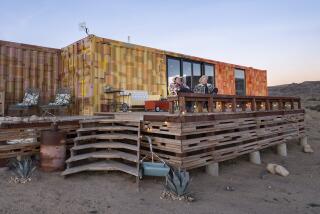Blue Sky in Palm Springs: Part-prefab house built in 4.5 months
As developer and project manager Dave McAdam walks through a newly built Palm Springs house dubbed Desert Two, he lists off the novel design elements: the swimming pool, smartly set in the frontyard instead of the back; the experimental ceiling, an expanse of steel with tiny perforations allowing cooled air to drift down into the glass-walled living area. Even the master bedroom has a surprise in back: a shower and bathtub on the deck outside.
LARGER-FORMAT PHOTO GALLERY: Desert Two house in Palm Springs
The novelty that can’t be seen? Desert Two’s sheer speed. Walls for the 2,200-square-foot house were framed in just three hours, McAdam says. Using 42 prebuilt steel panels from his Encino company, Blue Sky Building Systems, the crew framing Desert Two started at 8:30 a.m. one day in December and had all the walls up by 11:30 the same morning. All the rough framing, including the roof, was finished in three days instead of the usual three to six weeks. Total elapsed time, from pouring the foundation to showing off the finished design: just 4.5 months, a minor miracle of a timeline for anyone who has watched weeks whiz by just remodeling a kitchen.
Shortening the construction window translates into financial savings for a spec house rushing to make the most of a hot real estate market. This three-bedroom, two-bathroom house (plus that outdoor shower and tub) recently sold for $1,270,000.
Even critics of high-end prefab housing probably would admit that Desert Two’s partial factory-built origins are largely invisible. Anyone who visits will merely see a modern interpretation of the Palm Springs dream: a sun-soaked personal playground where the pool never feels far away, palm treetops peek through windows, and the evening view from the chaise is of Mt. San Jacinto, backlighted by a setting sun.
Rather than drop that poolside chaise into what architect Jim Jennings calls “a backyard that was sandwiched with other backyards,” he and McAdam shifted the footprint of the house toward the back of the property, creating a bigger front yard where the pool connects with the open-plan kitchen, dining and living area. The pool, Jennings says, “becomes an extension of that room.”
Adds McAdam: “You come through the front gate, and you feel like you’re already in the house.”
To give swimmers and sunbathers privacy and the house a greater sense of seclusion, the front yard is wrapped in oversized concrete block that exaggerates the horizontal lines of single-story structure.
“It’s 3 to 1 [width to height] proportion as opposed to common block, which is 2 to 1,” Jennings says of the blocks, each 2 feet wide.
The rest of the house is sheathed in icy white steel siding, industrial panels that not only camouflage the garage door and create an ethereal glow at night but also come with a functional benefit: a lifetime guarantee on the paint.
Inside, the house is essentially a square with mechanical, electrical and plumbing systems in a central core that splits the house into two zones — living spaces in front, bedrooms in back — while efficiently reducing the lengths of pipes, wiring and ventilation ducts.
The living area skips the custom floor-to-ceiling sliding glass doors that have become de rigueur in new modern homes. In their place are standard glass sliders topped with a band of fixed glass. Using off-the-shelf materials saved on costs and allowed Jennings to wrap the front of the house with another horizontal line, an effect heightened by the banded ceiling.
Corrugated steel on the ceiling carries more long lines overhead, from the living room to the kitchen. The “breathable ceiling,” as Jennings calls it, is something of an experiment in acoustics as well as aesthetics. Tiny perforations in the panels not only allow cooled air to drift down, the architect says, but also allow sound waves to pass through the steel and be absorbed in hidden material behind the panels. “Acoustically, it’s a very soft space,” he said. “With rectilinear and hard surfaces everywhere, that wouldn’t otherwise be the case.”
Buyers Mike and Sandy Waldman say they appreciated the house’s steel skeleton but ultimately were sold on its merits as a beautiful house, regardless of its construction back story.
“I like the fact that it’s steel, that I’m not going to have to worry about termites and the house isn’t going to require as much maintenance as wood or stucco,” Mike Waldman says. But in the end, the efficient floor plan, quality finishes and simple beauty are what sold them. “We really just liked the looks and features.”
That would please Jennings, who points out one more quality that he feels reflects the house’s essence.
“The whiteness — it’s something that I feel is emblematic of the desert environment: On the one hand, white is beautiful in how it captures light,” the architect says. “It can be harsh, but there is a purity and simplicity to it too.”
Twitter: @cnakano | Email: craig.nakano@latimes.com
JOIN THE CONVERSATION:@latimeshome | pinterest.com/latimeshome | facebook.com/latimeshome | facebook.com/latimesgarden
More to Read
Sign up for Essential California
The most important California stories and recommendations in your inbox every morning.
You may occasionally receive promotional content from the Los Angeles Times.







